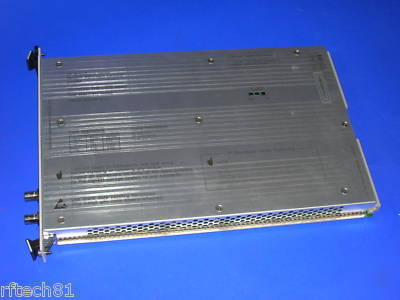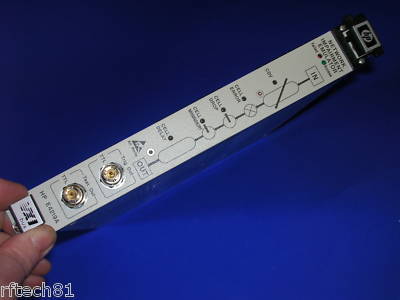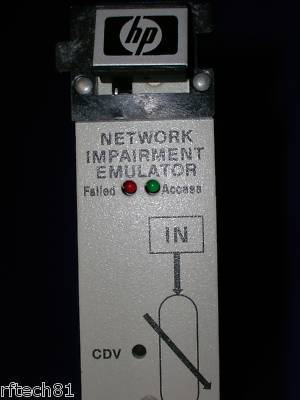Wisconsin Parts Database Instructions and Discussion Team/Group > INDIANA
> Machine Parts
> Add
> Hp/agilent E4219A atm network impairment emulator - vxi
Hp/agilent E4219A atm network impairment emulator - vxi
HP/Agilent E4219A ATM Network Impairment Emulator
The Agilent Technologies E4219A ATM Network Impairment Emulator module provides the capability to insert five impairment types cell loss, cell error, cell misinsertion, and cell delay into an ATM cell stream at rates up to 155 Mb/s. You can emulate noisy transmission lines, bufferring delays, satellite hops, traffic policing, switch malfunctions, etc. At a click of a mouse, you can set up any possible network impairment. Set cell delay and loss values to emulate a real-world network. Connect the impaired cell stream output to your system under test, and see what happens. Use the Agilent E4219A to find performance tolerances of your ATM network and CPE products, or determine service requirements when planning network capacity. For example, MPEG is very specific about the amount of jitter it allows. The ATM transport stream can introduce milliseconds of jitter. Combine the Agilent E6271 MPEGscope ATM for the BSTS and the Agilent E4219A to introduce the jitter and verify that equipment can remove jitter effectively.
Network impairment modules can be cascaded to increase total cell delay and cell delay variation. For higher layer and automated conformance testing, combine the E4219A with E4209 Cell Protocol Processor. The Agilent E4219 is a powerful tool for network equipment manufacturers, service providers, MPEG equipment manufacturers, R&D labs and CPE vendors, it runs on the industry-standard Agilent Broadband Series Test System. ATM Network Impairment Emulator
Key Features Emulates real-world impairments Inserts constant cell delay, cell delay variation, cell loss, cell error and cell misinsertion into an ATM cell stream. Impairment distribution Several statistical distributions, including user-defined, are available for cell error, cell loss, cell delay variation and cell misinsertion. Wide delay range Up to 220 ms (+/-3%) cell delay at 155 Mb/s Up to 2.57 ms (+/-3%) cell delay variation at 155 Mb/s Filter on any cell header Select impaired cell streams by field filtering on any ATM cell header field.
Cascade up to four modules to increase total delay or provide impairments for additional VPI/VCIs.
Applicable Standards Impairments ITU-T Recommendation I.356, B-ISDN ATM Cell Layer Cell Transfer Performance, 1993 ATM ITU-T Recommendation I.361 B-ISDN ATM Layer Specification, 1993 ITU-T Recommendation I.150 B-ISDN ATM Functional Characteristics, 1993
Configuration & Use With Other BSTS Line Interfaces,
Hardware Modules & Test Software The E4219A ATM Network Impairment Emulator can emulate impairments with all BSTS ATM-based line interfaces at rates up to 155 Mb/s.
Impairment Independent Parameters Channel Parameters ATM Header Matching or Misinsertion Values Variable Cell Delay Variable cell delays are caused by congestion, cell blocking and multiplexing. Delays can be specified in milliseconds or multiples of four cells; delay scales as a function of line rate. There is an initial delay associated with the data path of the E4219A which should be calibrated as described in the product documentation. Distribution Parameters Variable Cell Delay Range To quickly estimate maximum cell delay variation in seconds, divide 392,624 bits (926 cells x 53 octets per cell x 8 bits per octet) by line rate. Note that this calculation ignores any additional framing bits. Constant Cell Delay Constant cell delay results from fixed network delays, such as lengthy transmission distances and switching delays. Constant Cell Delay Range To quickly estimate maximum constant cell delay in seconds, divide 33,553,664 bits (79,136 cells x 52 octets per cell x 8 bits per octet) by line rate. Note that this calculation ignores any additional framing bits. Total Bandwidth Up to 149.76 Mb/s Modes UNI or NNI Empty Cell Definition Idle or unassigned VCI Any value 0 to 65536 VPI Any value 0 to 255 (UNI) or 0 to 4095 (NNI) GFC Any value 0 to 15 Payload Type Any value 0 to 7 Cell Loss Priority Any value 0 to 7 Cell Type ATM Binomial User-specified mean & standard deviation Geometric User-specified mean User Defined User-specified X,Y pairs representing desired probability density function CDV 0 to 926 cells
Distribution Parameters Cell Loss Cell loss results from such network problems as buffer overflow, switch malfunction, traffic policing, and uncorrectable header errors. The E4219A module can introduce bursts of up to eight consecutive cell losses. Lost cells can be replaced either by idle cells or by cells with user defined headers.
Cell Misinsertion Cell misinsertion is caused by transmission errors and situations where an undetected header error matches an existing VPI/VCI. The header of the misinserted cell can be fully specified by the user. The first two and last two payload octets of the misinserted cell can be independently specified. A fill pattern for payload bytes 3-46 can also be specified.
Distribution Parameters External Triggers External TTL trigger pulses may be output through the connector on the E4219A front panel. This allows the module to work in conjuction with other hardware. Triggers can be output under the following circumstances. Normal User-specified mean error interval from 5 to 2E10 cells or 1000 to 1E12 bytes with user-specified deviation Exponential User-specified mean error interval from 5 to 2E10 cells or 1000 to 1E12 bytes Deterministic User-specified cell error rate from 5E-11 to 2E-1; byte error rate from 1E-12 to 1E-3 Uniform User-specified lower error interval limit of 5 cells or 1000 bytes; user-specified upper error interval limit of 2E10 cells or 1E12 bytes User Defined User-specified X,Y pairs representing error intervals from 5 to 2037-1 cells or 1000 to 232-1 bytes with associated probability from 0.0 to 1.0 Normal User-specified mean error interval from 1000 to 1E12 cells with user-specified standard deviation Exponential User-specified mean error interval from 1000 to 1E12 cells Deterministic User-specified cell error rate from 1E-12 to 1E-13 Uniform User-specified lower error interval limit of 1000 cells User-specified upper error interval limit of 1E12 cells User Defined User-specified X,Y pairs representing error intervals from 1000 to 232-1 cells with associated probability from 0.0 to 1.0 Normal User-specified mean error interval from 1000 to 1E12 cells with user-specified standard deviation Exponential User-specified mean error interval from 1000 to 1E12 cells Deterministic User-specified cell error rate from 1E-12 to 1E-13 Uniform User-specified lower error interval limit of 1000 cells User-specified upper error interval limit of 1E12 cells User Defined User-specified X,Y pairs representing error intervals from 1000 to 232-1 cells with associated probability from 0.0 to 1.0 Variable Cell Delay The delay value changes Cell Misinsertion A cell has been misinserted by the module Cell Error A byte or cell has been errored by the module Cell Loss A cell has been lost by the module Constant Cell Delay A cell has been delayed by the module Incoming The module detects an incoming non-empty cell Outgoing The module detects an outgoing non-empty cell
Cells received through the cell bus from the module are inpaired by the E4219A, then looped back through the cell bus to the same module Cascaded Default interface mode when the test application includes another module located to the left of the E4219A on the VXI (i.e. a CPP)
Use two or more E4219A modules to create very lengthy delays or apply different impairments to other virtual channels or paths
Cells received through the cell bus from the module on the right pass through the E4219A without sampling or modification
Cell received through the cell bus from the module on the left are impaired by the E4219A, then sent through the cell bus to the next module on the right
Disabled This mode is used when the E4219A is to be temporarily removed from the application without having to stop the application and start a new one
Cells received through the cell bus from modules to the right or left pass through the E4219A without modification.
Size 1 slot, C-size VXI card Weight 1.3 kg (2.9 lb) nominal Operating temperature 0 to 55 C Storage temperature -40 to 75 C Humidity 50 to 95% RH over 25 to 40 C Safety Conforms with EN 61010:1993/IEC 1010-1:1990+A1 EMC Conforms with EN 55011:1991/CISPER 11:1990 (Group 1, Class A) EN 50082-1:1992 IEC 801-2:1991 IEC 801-3:1984 IEC 801-4:1988





